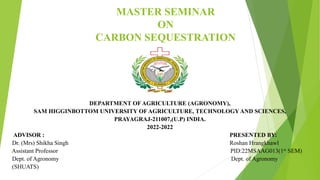
CARBON SEQUESTRATION: ROSHAN HRANGKHAWL(MASTER SEMINAR).pptx
- 1. MASTER SEMINAR ON CARBON SEQUESTRATION DEPARTMENT OF AGRICULTURE (AGRONOMY), SAM HIGGINBOTTOM UNIVERSITY OF AGRICULTURE, TECHNOLOGY AND SCIENCES, PRAYAGRAJ-211007,(U.P) INDIA. 2022-2022 ADVISOR : PRESENTED BY: Dr. (Mrs) Shikha Singh Roshan Hrangkhawl Assistant Professor PID:22MSAAG013(1st SEM) Dept. of Agronomy Dept. of Agronomy (SHUATS)
- 2. INTRODUCTION Carbon sequestration is the process involved in capturing and the long-term storage of carbon in a carbon pool. In other words, it also refers to the process of removing carbon from the atmosphere and depositing it in a reservoir. Also known as ‘carbon capture and storage’ (CCS). It is one method of reducing the amount of carbon dioxide in the atmosphere with the goal of reducing global climate change. Carbon Sequestration is the placement of CO2 into a depository in such way that it remains safely and not released back to the atmosphere.
- 4. OBJECTIVES : Reducing pollution in air as well as improving natural carbon content in soil. Improvement of soil structure and restoring degraded soil leading to increase yield in crops. Developing technology to reduce rate of concentration of greenhouse gases in air. Reducing the amount of CO2 in the atmosphere which will lessen the impacts of global climate change.
- 5. SOURCE OF CARBON A carbon source is anything that releases more carbon into the atmosphere than it absorbs. Man made sources : Industries Transportation Land use change Soil cultivation Biomass burning
- 6. Natural sources : Volcanoes Wildfires Decomposition Respiration
- 7. CARBON SINK An area that absorbs carbon or store carbon amount. A carbon sink is anything that absorbs more carbon from the atmosphere than it releases. Natural Sinks : Vegetation, Oceans, Forests, Soil, etc. Artificial Sinks : Depleted oil reserves, Unmineable mines, etc. Two types :
- 8. (i). Terrestrial Sequestration (In plants and soil) : The process through which CO2 from the atmosphere is absorbed naturally through photosynthesis & stored as carbon in biomass & soils. (ii). Geological Sequestration (Underground) : Natural pore spaces in geologic formations serve as reservoirs for long term CO2 storage. (iii). Ocean Sequestration (Deep in ocean) : Carbon is naturally stored in the ocean via two pumps i.e. solubility and biological. Also, there are analogous man made methods such as direct injection and ocean fertilization, respectively. At the present time, approximately one third of human generated emission are estimated to be entering the ocean. TYPES OF CARBON SEQUESTRATION :
- 9. IMPORTANCE OF CARBON SEQUESTRATION Helps in reducing Greenhouse gas emissions into the atmosphere. Enables low – carbon electricity generation from power plants. Improved soil structure. Less erosion. Increased soil fertility. Improved biodiversity. Healthier ecology.
- 10. METHODS OF CARBON SEQUESTRATION: It is the process by which nature has achieved a balance of carbon dioxide in our atmosphere suitable for sustaining life. Animals expel carbon dioxide, as do plants during the night. Nature provided trees, the oceans, earth and the animals themselves as carbon sinks, or sponges. All organic life on this planet is carbon based and when plants and animals die, much of the carbon goes back into the ground where it has little impact on contributing to global warming. Artificial carbon sequestration refers to a number of processes whereby carbon emissions are captured at the point of production (e.g. factory chimneys) and then buried. One proposed method is ocean sequestration whereby carbon dioxide is injected deep into the ocean, forming lakes of CO2. In theory, the CO2 will stay down deep due to the pressure and temperature of the surrounding water, gradually dissolving into that water over time. Another example is geological sequestration where the carbon dioxide is pumped into underground chambers such as old oil reservoirs, aquifers and coal seams that are unable to be mined. Natural Carbon Sequestration: Artificial Carbon Sequestration :
- 11. Fig :Natural Carbon Sequestration Fig : Artificial Carbon Sequestration
- 12. CONCLUSION Plant trees to create carbon sinks(Afforestation). Protect existing forests to reduce emissions from deforestation(Forest preservation and avoiding deforestation). Improve forestry techniques to reduce emissions(Active forest management). Replacing high-energy materials with climate-friendly substitutes. Fossil fuel substitution through renewable wood energy. Greenhouse gas concentration in the atmosphere are increasing and the threat of global climate change requires our attention. It can be overcome by keeping in mind the following points :
- 13. THANK YOU